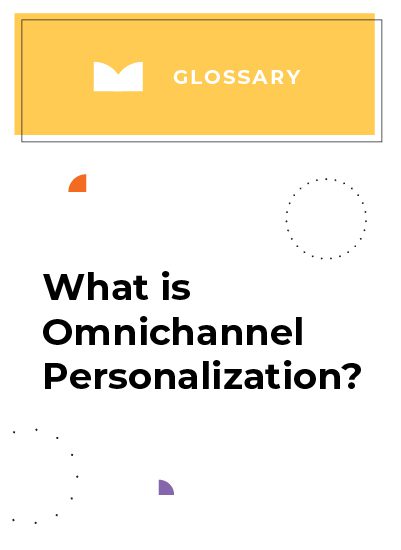
Omnichannel Personalization
What is Omnichannel Personalization?
Omnichannel Personalization is the practice of creating customer experiences that are informed by real-time data from all channels, and extending them across every touchpoint, to build consistent relationships with the customer everywhere they interact with the brand.

A common misconception is that “omnichannel” means “within” multiple channels—in other words, that it’s a matter of taking separate actions in multiple siloed channels. In reality, it means something much more powerful: the ability to personalize “across” all channels—including web, mobile, in-store, email and direct mail channels—which means combining the ability to understand how an individual interacts with a brand in all channels, with the ability to act on that understanding by customizing their experience across every touchpoint. “Omnichannel personalization” therefore refers to both the capacity to collect information with unprecedented breadth, and the ability to deploy it no matter where the interaction takes place, for a consistent and contextually informed customer experience.
The historical approach to omnichannel was primarily focused on the variety of channels, not on an integrated customer experience. When retailers started to expand their brick and mortar to web, email, display, mobile, etc. they developed infrastructure within each of these channels which allowed channel-specific teams to execute on traditional segmentation and A/B testing within their respective channel. However, at the same time, it created silos and a mix of structured and unstructured data. This meant that siloed infrastructure prevented marketers from gaining an understanding of the customer and designing unique interactions with each person across channels. “Omnichannel personalization” represents the effort to re-integrate the distributed touchpoints of a consumer’s relationship with a brand into a unified experience.
Omnichannel Customer Experience
This is a user experience that is consistent across media and platforms. By integrating both data collection and personalization efforts across all channels, brands are able to offer a unified omnichannel customer experience that understands each interaction as part of an ongoing relationship between consumer and brand.
Customers are infiltrated with communications from brands coming from every direction, but study after study shows that consumers actually want a relationship with brands, and desire a consistent experience across channels. Brands are also beginning to understand that the buying journey isn’t always linear: consumers may begin their shopping on a website, but they will often interact with the brand through a variety of other channels, before and after purchase, over the course of the relationship. When brands focus on pushing consumers down the funnel of a narrowly-defined buying cycle, they create disjointed experiences that fail to connect with consumers.
The challenge for brands is therefore to remain relevant, and maintain a smooth and consistently impressive customer experience, that spans both time and touchpoints.
As the industry trend moves consistently toward comprehensive omnichannel personalization, those brands that fail to recognize users across devices will stand out for their inability to provide a smooth customer experience. Luckily, the growing sophistication of ecommerce personalization solutions means that the technology to make these changes is more accessible than ever before. There’s never been a better time to start capitalizing on this data and taking advantage of the brand improvements that it can precipitate.
How to get started with Omnichannel Personalization?
Implementing Omnichannel Personalization can be a complex process, and it is just as much about organizational alignment and strategy as it is about technology. It helps to have a clear starting point. This checklist outlines the first steps to get you started with Omnichannel Personalization:
- Establish organization buy-in for omnichannel personalization: involve your C-suite if possible
- Set measurable goals and build a strategy around those goals
- Conduct a data inventory. Understand what is available and how it could be leveraged to achieve your goals
- Align on an internal governance model for executing your omnichannel strategy
- Build an omnichannel personalization roadmap of use cases (experience types, rules, content, code, success metrics, scheduling)
Omnichannel Personalization Platform
Your personalization platform and strategy need to be everywhere your customers are — online, offline, in-store, email, or phone. To achieve this, you need very specific capabilities:
An Open Infrastructure
An open infrastructure is able to connect to all of your siloed systems or applications, including old, siloed databases that were set up years ago, to allow for bridging data together and turning it into customer intelligence that can be acted upon.
Real-Time Decision Making
Real-time technology enables in-the-moment decisions. Given how often a customer’s needs, behaviors, and interests tend to change in this highly connected era, being able to gather information and take action instantaneously is a requirement for serving experiences that are relevant to the consumer.

Omnichannel Customer Identification
In order to provide a consistent experience to each person, you need a way to recognize the same visitor when they reach you on different channels. By establishing an omnichannel customer profile for each person based on a unique customer ID, you build the foundation for the customer-brand relationship.
You also need a way to build, manage and deliver a wide range of experiences to customers across channels, including AI-driven content personalization, product recommendations, traditional segmentation, behavioral targeting, and testing. And each of these have their own purpose depending on your personalization strategy.